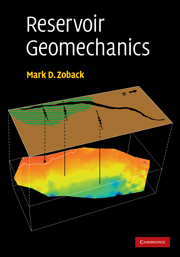Book contents
- Frontmatter
- Contents
- Preface
- PART I BASIC PRINCIPLES
- PART II MEASURING STRESS ORIENTATION AND MAGNITUDE
- 6 Compressive and tensile failures in vertical wells
- 7 Determination of S3 from mini-fracs and extended leak-off tests and constraining the magnitude of SHmax from wellbore failures in vertical wells
- 8 Wellbore failure and stress determination in deviated wells
- 9 Stress fields – from tectonic plates to reservoirs around the world
- PART III APPLICATIONS
- References
- Index
- Plate section
9 - Stress fields – from tectonic plates to reservoirs around the world
Published online by Cambridge University Press: 10 December 2009
- Frontmatter
- Contents
- Preface
- PART I BASIC PRINCIPLES
- PART II MEASURING STRESS ORIENTATION AND MAGNITUDE
- 6 Compressive and tensile failures in vertical wells
- 7 Determination of S3 from mini-fracs and extended leak-off tests and constraining the magnitude of SHmax from wellbore failures in vertical wells
- 8 Wellbore failure and stress determination in deviated wells
- 9 Stress fields – from tectonic plates to reservoirs around the world
- PART III APPLICATIONS
- References
- Index
- Plate section
Summary
In this chapter, I discuss in situ stress fields at a wide variety of scales – from global patterns of tectonic stress (with a brief discussion of the sources of large-scale tectonic stress) to examples of normal, strike-slip and reverse faulting stress states in different sedimentary basins around the world. The purpose of this review is to (i) illustrate the robustness of the stress measurement techniques discussed in Chapters 6–8, (ii) emphasize the fact that sedimentary basins are, in fact, found in normal, strike-slip and reverse faulting environments (as discussed in Chapter 1) and (iii) demonstrate that critically stressed faults are found in many sedimentary basins such that stress magnitudes are often found to be consistent with those predicted on the basis of frictional faulting theory (as discussed near the end of Chapter 4).
In this chapter I also review empirical methods used for stress magnitude estimation at depth. Specifically, I provide an overview of some of the techniques being used for estimating the magnitude of the minimum principal stress in normal faulting environments (such as the Gulf of Mexico) for cases where direct measurements of the least principal stress from extended leak-off tests and mini-fracs are not available. I discuss in detail one particular model, the bilateral constraint, which has been widely used for stress estimation at depth using values of Poisson's ratio from geophysical logs.
- Type
- Chapter
- Information
- Reservoir Geomechanics , pp. 266 - 298Publisher: Cambridge University PressPrint publication year: 2007

